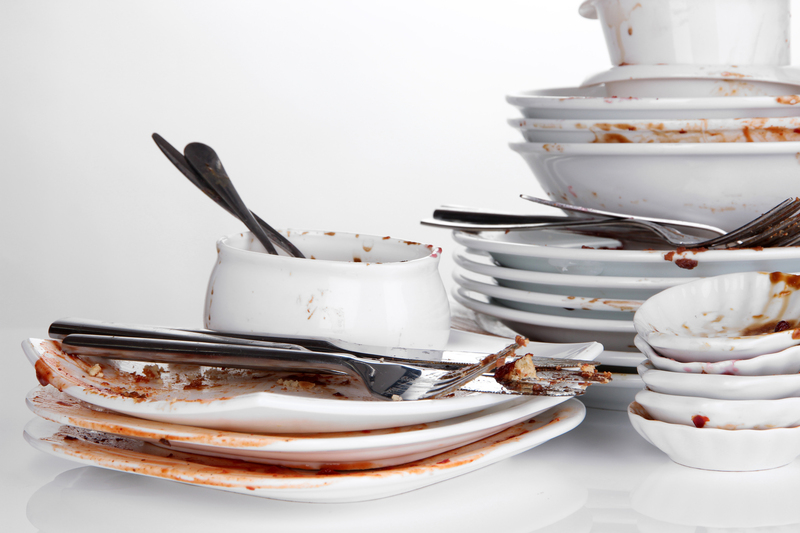Mastering the Art of Cleaning Velvet Curtains Safely
Posted on 02/06/2025
Mastering the Art of Cleaning Velvet Curtains Safely
When it comes to interior elegance, few things make as dazzling a statement as sumptuous velvet curtains. Their plush, lustrous texture and deep, rich colors evoke luxury and warmth in any room. However, caring for velvet is another story entirely. If you want to preserve their beauty, learning how to clean velvet curtains safely is an essential skill for any homeowner or decorator.
In this comprehensive guide, you'll discover the secrets to mastering the art of velvet curtain care--from daily maintenance to deep cleaning methods--so your drapery stays as stunning as the day you hung it!
Table of Contents
- Why Clean Velvet Curtains Properly?
- Understanding Velvet Fabric Types
- Essential Pre-Cleaning Steps for Velvet Curtains
- Top Methods for Cleaning Velvet Curtains Safely
- Tips for Spot Cleaning Velvet Curtains
- Deep Cleaning Techniques
- Drying and Ongoing Maintenance
- Common Mistakes to Avoid
- Frequently Asked Questions
- Conclusion: Preserve Your Velvet for Years
Why Is Proper Velvet Curtain Cleaning So Important?
Velvet is more than just fabric--it is a living detail in your decor, instantly enhancing a room's ambiance. However, velvet's dense pile and plush fibers naturally attract dust, pet hair, and even moisture from the air. Over time, neglecting your velvet curtains can cause:
- Fading of vibrant colors
- Staining from accidental spills
- Flattened pile and loss of signature softness
- Mold or mildew in humid climates
That's why velvet curtain cleaning goes beyond simple dusting--it's about extending your investment and preserving the fabric's visual and tactile allure for years to come.
Understanding Different Types of Velvet Curtains
Before learning how to clean velvet drapes safely, it's crucial to identify what type of velvet hangs in your home. Each variety demands distinct care.
Common Types of Velvet Used in Curtains:
- Cotton Velvet: Natural, soft, and luxurious, but sensitive to water spots and shrinkage.
- Silk Velvet: Irresistibly smooth, delicate, and often the most expensive; requires extreme caution.
- Rayon or Viscose Velvet: Often blended with synthetic fibers for durability, but still prone to fiber crushing and staining.
- Polyester Velvet: The most resilient and stain-resistant option--ideal for active households.
Tip: Always check the manufacturer's care label and test any cleaning method on a hidden area before proceeding.
Essential Pre-Cleaning Steps for Velvet Curtains
Before diving into cleaning, careful preparation is vital to *protect the integrity* of velvet fibers and color. Here's how to prepare your curtains for optimal cleaning results:
- Dust Removal: Gently shake or vacuum velvet curtains using an upholstery brush attachment (always on the lowest suction setting).
- Spot Testing: Dab a small amount of water or chosen cleaning product on an inside hem to check for colorfastness or texture changes.
- Check for Stains: Identify any spills or spots that require targeted treatment before general cleaning.
- Remove Hardware: Take curtains off rails and detach hooks or rings to avoid snagging and ensure thorough cleaning.
*Being methodical at this stage helps ensure your delicate drapes emerge spotless and undamaged!*
Safe Methods for Cleaning Velvet Curtains
The safest approach to cleaning velvet curtains depends on the fiber type, age, and local climate. Explore these tried-and-tested techniques:
1. Professional Dry Cleaning
For silk, antique, or precious velvet drapes, professional dry cleaning is the gold standard. Dry cleaners have the expertise and equipment to clean delicately without risking fiber distortion or water marks.
- Advantages: Safest for fragile or vintage velvet
- Disadvantages: Costly and requires two trips to/from the cleaners
2. Steaming Velvet Curtains at Home
Steaming is an excellent way to refresh velvet drapes and remove light odors or wrinkles. Use a handheld garment steamer and hold it at least 1 inch from the fabric's surface. Never let direct heat or water droplets collect on the velvet.
- Restores the pile and eliminates minor creases.
- Keep movements even and gentle to avoid "steam spots".
3. Safe Manual or Hand Washing
Some modern polyester or blended velvets can be gently handwashed, but this requires extreme care:
- Fill a bathtub or sink with cold water and add a tiny amount of mild detergent.
- Submerge curtains fully (one panel at a time), agitating lightly for 2-3 minutes.
- Rinse thoroughly in cool water, supporting the fabric to prevent stretching.
Tip: Never wring out velvet! Instead, press between towels to remove excess moisture.
4. "No-Water" Brushing and Maintenance
For regular upkeep, a soft-bristled velvet brush or lint roller can be used to gently lift surface dust and revive the pile without moisture or chemicals.
Spot Cleaning Velvet Curtains the Right Way
Accidents happen... Whether it's a splash of wine or muddy pet paws, quick action is crucial. Here's how to treat stains on velvet curtains while keeping the fabric flawless:
- Blot, Don't Rub: Use clean, absorbent towels to gently blot (not scrub!) the spill, drawing out as much moisture as possible.
- Use Mild Solutions: For oil-free stains, mix a few drops of dish soap with cold water. For organic stains, try a diluted mix of white vinegar and water.
- Apply with Care: Dab the solution onto the stain with a clean white cloth, working from the outside in to prevent spreading.
- Rinse and Blot Again: Finish by blotting with a water-dampened towel, then let air dry completely. Comb the pile gently if needed.
Never oversaturate velvet or rub aggressively--this can flatten the pile or cause discoloration!
Deep Cleaning Velvet Curtains at Home
For periodic deep cleans (every 1-2 years), your options will depend on the care label:
- Professional Dry Cleaning: Recommended for most natural or classic velvets and expensive drapes.
- At-Home Hand Washing: Possible with durable poly-blend velvets--always use cold water and minimal detergent.
Quick Guide for Home Deep Cleaning:
- Pre-vacuum both sides of the curtain using a soft brush attachment.
- Spot treat any visible stains first (as described above).
- For hand-washable velvet, submerge and gently agitate in a cool water/detergent mix for 2-3 minutes, then rinse thoroughly.
- Roll the cleaned curtain panel in towels to absorb moisture, then hang or lay flat (away from direct sun) to dry.
- For best results, use a steamer after drying to revive the signature velvet pile.
*If in doubt, always choose professional dry cleaning or consult the manufacturer's recommendations.*
Drying and Maintaining Velvet Curtains
The Best Way to Dry Velvet Curtains
- Avoid dryers: Excess heat from household dryers will ruin velvet's texture and may cause permanent shrinkage or 'bruising' of the pile.
- Hang curtains from a wide rod or padded hanger in a well-ventilated room. Lay towels underneath to catch drips.
- Smooth gently: Regularly smooth the drapes with your hands as they dry to prevent creasing and flattening.
- Use a cool steamer after drying to lift and re-fluff the pile.
Daily and Weekly Maintenance Tips
- Dust regularly with a velvet brush or handheld vacuum (using a soft brush tool).
- Keep windows closed during high pollen or dust seasons.
- Protect from direct sunlight to prevent fading of bright or rich colors.
- Rotate or adjust drapes periodically to allow even exposure and wear.
*Consistent upkeep is the key to keeping velvet looking radiant and new!*
Common Velvet Curtain Cleaning Mistakes to Avoid
- Skipping the care label: Always read and follow manufacturer guidelines.
- Using hot water: Hot water shrinks and distorts the velvet pile. Stick to cold or lukewarm.
- Applying bleach or harsh chemicals: These can bleach or burn the delicate fibers.
- Scrubbing vigorously: This causes the pile to crush and lose its sheen.
- Wringing the fabric: Always press between towels rather than wringing or twisting velvet.
- Over-saturating: Excess water soaks into the backing and causes shrinking or rippling.
Frequently Asked Questions About Cleaning Velvet Drapes
- Can I machine wash my velvet curtains?
- Generally, no. Only some modern polyester-blend velvets are machine washable (on delicate/cold), and even then, hand washing is safe. Always check your curtain's care label before attempting machine cleaning.
- How often should velvet curtains be cleaned?
- Lightly dust or vacuum once every few weeks, spot clean as needed, and perform deep cleaning once every 12-24 months for optimal freshness.
- What's the best way to remove pet hair from velvet drapes?
- Use a soft velvet brush or lint roller, moving in the direction of the pile. A vacuum with a brush attachment also works very well.
- Can sunlight damage velvet?
- Yes, direct sunlight can cause fading and deterioration over time. Use window linings or UV-protective films to safeguard your curtains.
- What should I do if my velvet curtains develop water spots?
- Let the spot air dry completely, then steam gently and brush the pile with a velvet brush to restore texture. Persistent marks may require professional attention.
Conclusion: Master the Safe Cleaning of Velvet Curtains
Velvet curtains are a show-stopping centerpiece in any home, but their beauty demands gentle, knowledgeable care. By using the right techniques for cleaning velvet curtains safely, you not only prolong their splendor but also ensure a healthier, more vibrant living space.
Remember:
- Always identify your velvet type before cleaning.
- Begin with gentle dusting or professional steam cleaning.
- Treat stains promptly and carefully.
- Avoid harsh chemicals, excessive water, and direct sunlight.
- For precious or antique velvet, leave the cleaning to the professionals.
With these expert tips, mastering the art of velvet curtain care is easier than ever. Enjoy the deep, luxurious beauty of your curtains for years--one safe, attentive clean at a time!











